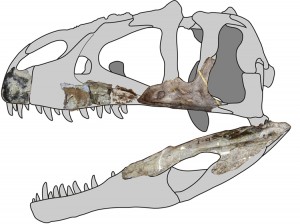Thailand’s New Shark-Toothed Dinosaur
Friday, October 18th, 2019October 18, 2019
Recent excavations in central Thailand have led to the discovery of a new type of predatory dinosaur, Siamraptor suwati. The ancient creature belonged to a group of giant meat-eaters called carcharodontosaurs, which means shark-toothed reptiles. Siamraptor dates from the Cretaceous Period, a time in Earth’s history from about 145 million years ago to 66 million years ago. The Cretaceous was the last of the three periods that make up the Mesozoic Era, the time when the dinosaurs lived.

Fossils found in Thailand helped scientists reconstruct the skull of the newly identified Siamraptor suwati dinosaur. Credit: Duangsuda Chokchaloemwong, et al/Nakhon Ratchasima Rajabhat University
Siamraptor (Siam is the previous name for Thailand; raptors were carnivorous, bipedal dinosaurs) is the first example of a carcharodontosaur to be found in Southeast Asia. Previous examples came from northern Africa and Europe, and close cousins have been found in Argentina (Giganotosaurus) and the United States (Acrocanthosaurus).
The fossilized bones of Siamraptor were found in 115-million-year-old rocks in the central Thai district of Ban Saphan between 2008 and 2013. Paleontologists from Thailand’s Nakhon Ratchasima Rajabhat University found the fossils—22 in all—while working on a project with Japan’s Fukui Prefectural Dinosaur Museum. The announcement that the fossils belonged to a new type of carcharodontosaur came in October 2019 after years of study. Siamraptor was not the first find for the Japan-Thailand Dinosaur Project. The team earlier identified two new types of plant-eating dinosaurs and an ancient relative of the alligator and crocodile.

Twenty-two fossils aided in the skeletal reconstruction of Siamraptor suwati. Credit: Duangsuda Chokchaloemwong, et al/Nakhon Ratchasima Rajabhat University
The Siamraptor fossils include parts of a single animal’s feet, hands, hips, spine, and skull. The animals’s bones were somewhat porous, containing air sacs that would have made the creature a lighter and more agile hunter. Nearby were also many Siamraptor teeth, suggesting that this animal had not been alone. Like sharks, dinosaurs shed teeth throughout their lives, particularly when they ate, and the Ban Saphan site (a floodplain during the Cretaceous Period) may have been a common feeding ground. Siamraptor probably preyed on plant-eating dinosaurs in the area, using its bladelike serrated teeth—measuring up to 6 inches (15 centimeters) long—to slice through tough dinosaur flesh.
Scientists classify Carcharodontosaurus with other meat-eating dinosaurs in a large group known as theropods. These animals make up one of two main groups of saurischian (lizard-hipped) dinosaurs. Saurischians include such famous dinosaurs as Tyrannosaurus and Velociraptor. Although Carcharodontosaurus is classified in the same main group as Tyrannosaurus and Velociraptor, it was not closely related to them.
Tyrannosaurus and Carcharodontosaurus shared such traits as big heads, long bodies, and short arms, but the animals’ snouts were quite different. Tyrannosaurus had a broad head and a wide mouth with teeth made for crushing bone and pulling away flesh. Carcharodontosaurus had a much narrower head and a more precise bite with sharper teeth meant for slicing flesh. The two apex predators (at the top of the food chain) appear to have coexisted in several areas, which probably made for some rather interesting confrontations.


